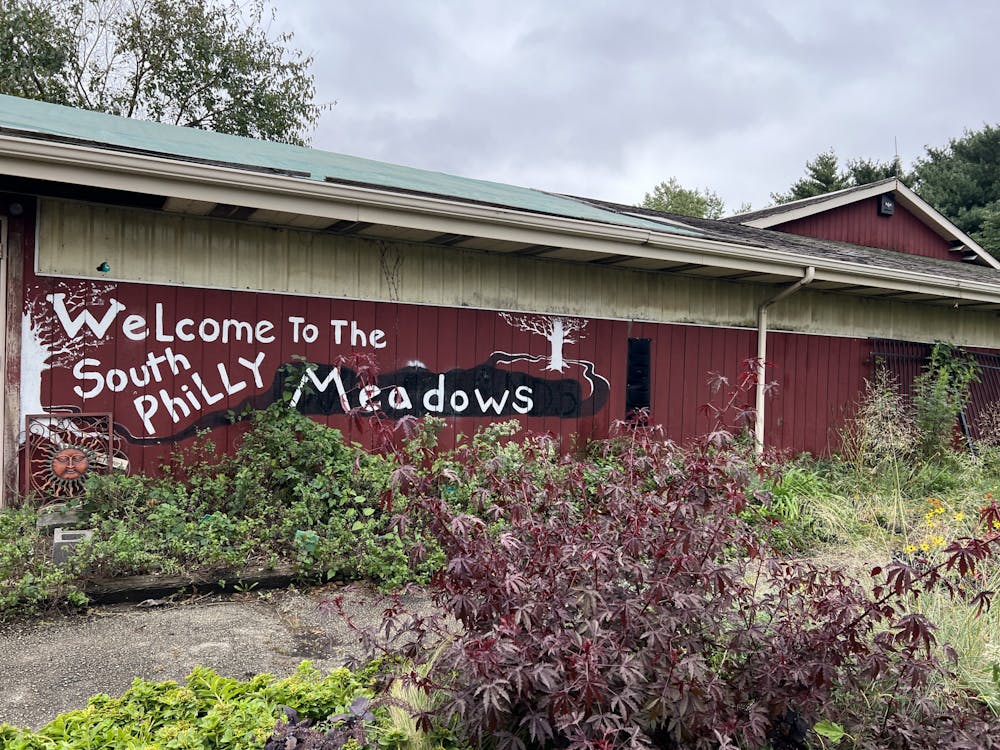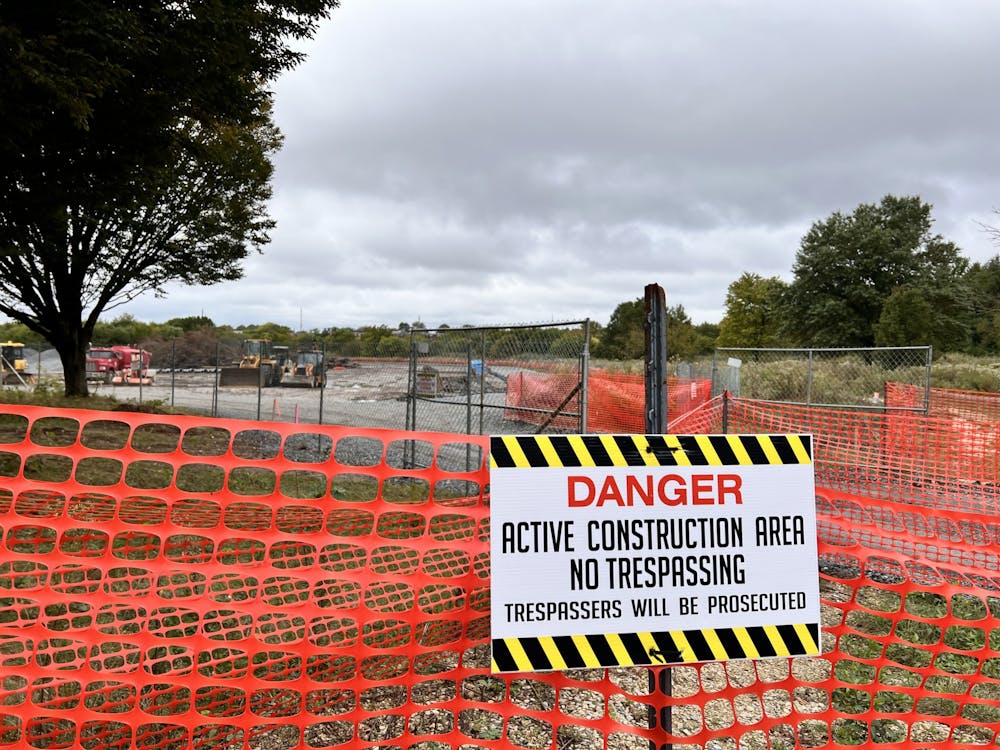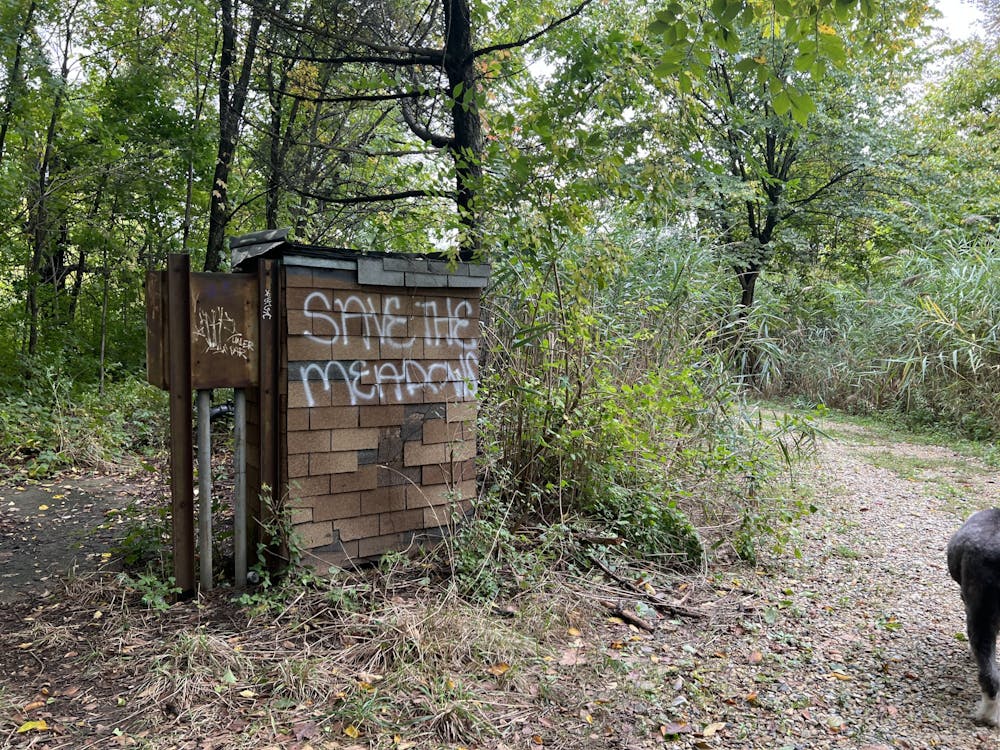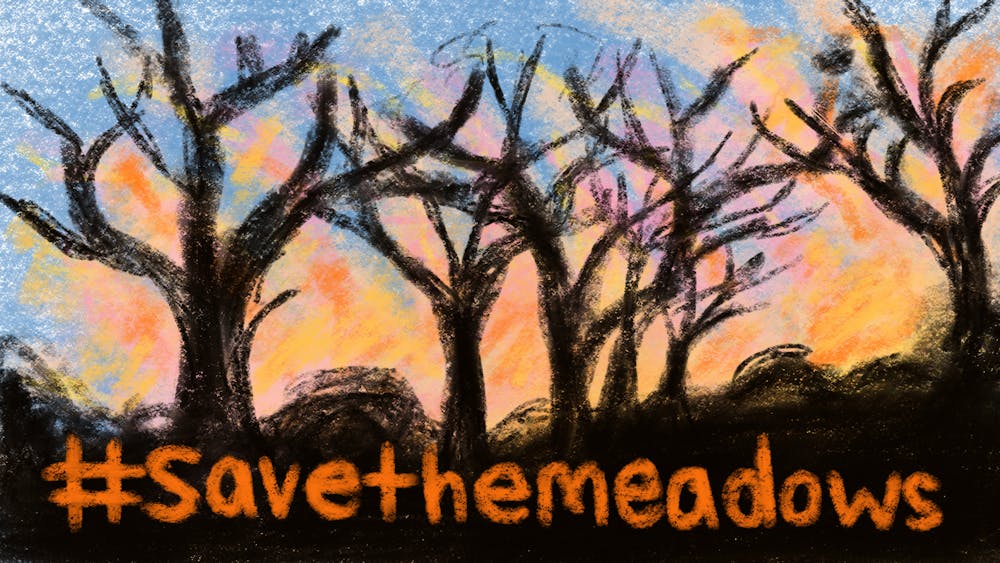Catia Colagioia (C ‘24) grew up less than a mile away from South Philadelphia’s Franklin Delano Roosevelt Park—one of the city’s oldest woodlands.
Perhaps better known by its nickname, “The Lakes,” FDR Park is located at the last stop on the Broad Street Line. The park was an integral part of Catia’s childhood, with her family’s relationship to The Lakes tracing back to when her grandparents first immigrated to the South Philadelphia area and would regularly pick fruits and vegetables in the woodlands.
“[Going to The Lakes] was something that was passed down to me. We would go there and forage mushrooms and pokeberries,” she says. “It was a special place in that sense … and it was really the only green space I knew.”
Up until a month ago, the woodlands covered the northwest corner of the park in oak, cedar, and ginkgo trees so dense that, even in the winter, the neighboring I–95 highway was rendered both invisible and silent by their insulation. It was one of Philadelphia’s only inner–city oases of nature—entirely isolated from urbanization, whether it be the tangle of Broad Street and the Delaware Expressway or the general Packer Park neighborhood.
A little farther east of the woodlands sits what’s become known as the South Philly Meadows, a green space that occupies what was formerly the FDR Park Golf Course.
After the decommissioning of the golf course in 2019, the land—left alone for the first time in decades—seemed not to know what to do with itself. Puddles of flat lawn that were once putting greens became home to wildflowers and milkweed. Concrete paths as wide as golf carts became hiking trails, and ponds that were once fairway hazards suddenly held six–foot cattails. Red–winged black birds and blue jays spun in the air over powdery lilacs and tall grass—far from the city.

A community sprouted in the course’s wake, full of South Philadelphians who began using the public area for guided yoga meditations and bird walks. Now, that community is in danger.
Deena Willow, the Meadows’ unofficial caretaker, walks through what is left of the area—which she calls “Narnia.”
“We have to go the long way,” she sighs, as her dog trails behind her on the newly paved gravel road that slashed through what was once a knee–high field of daisies and clover. “Is this our trail?” she asks. “They constantly change it.”
Navigating through patchy construction sites, she describes the Fairmount Park Conservancy’s “master plan” for FDR Park.
Unveiled in 2022, the latest version of the master plan involves a complete remodel of the park. Construction for the first phase of the plan, the Gateway Phase, began abruptly and forcefully in August. It ambitiously promises to be done by July 2023, at which point a ribbon will be cut on the newly installed Welcome Center and the Anna C. Verna Playground.
By the time that construction is completed, sports fields and play areas will all but replace the woodlands that Catia and so many other local residents once frequented.
Although construction began this past summer, the idea for the master plan first arose over five years ago.
In 2016, the Philadelphia International Airport began scouting for an area where it could restore wetland as compensation for launching a cargo development plan that would infringe on waterbeds near the airport’s western end. Philadelphia’s Department of Parks and Recreation called on the Fairmount Park Conservancy to carry out this search on their behalf.
Allison Schapker, the chief project officer at the Fairmount Park Conservancy, says, “The city began to look hard at FDR Park, knowing that we faced a hotter and wetter future with climate change.” Before the city was founded, a portion of FDR Park was marsh and wetland–like, but it has since lost its organic state. In addition, the park has been experiencing frequent flooding, also making it a popular option to revitalize wetland. Schapker explained that the plan’s priority was water management, as the park is below sea level and prone to flooding.
“There is more influence of groundwater flooding,” she says. “High tide pushes up through the ground, and water is flying off the roads into the creek.” To relieve not only flood damage but also improve the quality of the city’s water, the conservancy’s plan is defined by two concentric pillars: an “urban edge” with an “ecological core.”
Here, buildings like a boathouse or Fieldhouse concessions would border a palm print of wetlands and forests. Unfortunately, the Meadows is a damp and green environment that lies on one of the park’s edges—meaning it would not fit into this model.
The corner where the Meadows once lived is set to house 12 multipurpose AstroTurf athletic fields. Advocates of the project believe that Philadelphia’s youth have long deserved safe and functioning athletic complexes. “The number of families in South Philly is growing,” Schapker explains. And out of all of the sports facilities in the city, “only ten are full fields to hold an actual game.”
City Councilmembers, especially Councilmember Kenyatta Johnson, see the plan as inherently anti–violent. Spokesperson for the Fairmount Park Conservancy Cari Bender echoes Johnson, saying that “a way to get kids off the streets is to give them something to do. Give them sports to play and activities to attend.” As Schapker says, “Public space is a tremendous equalizer.”
In 1913, the park was designed by the Olmsted Brothers—the architects also credited with designing Central Park. They based their original plan on the intention that recreation and nature should be separate so that it would be possible to fully immerse yourself in one or the other. Initially, the east side of Broad Street was dominated by a full–sized running track, while the west was a mosaic of lakes and lawns framed with garlands of dark trees.
This lush sketch has since devolved as Citizens Bank Park and Lincoln Financial Field claimed its east side, and flat areas allocated to sports facilities have been moving westward ever since. So why not simply renovate the Richie Ashburn Fields, already existing baseball diamonds, and multiple tennis courts already spread throughout the park?
The new sports fields planned by the conservancy are certainly an answer to the prayers of Philly youth, but the question the community is asking is not about whether to provide them, but where.
Why the Meadows?
“What currently exists today is an old golf course that is being kept dry by a pump from the 1960s and ‘70s,” Schapker says. “When it was a golf course, there was a tremendous application of herbicides and pesticides that kept that lawn in place … it is about to become entirely overrun by invasive species.”
Schapker specifically refers to Japanese knotweed, a plant that’s been bullying out native species and serves as poor food sources for local animals. “What we have today isn’t natural. It isn’t permanent, and we are trying to achieve long–term sustainability for climate change,” she says.
The Fairmount Conservancy defends its plan, saying that by elevating outer land while concentrating wetland in the middle of the park makes the structure a fortified sponge. From a geological perspective, wetland is the most effective biome for preventing the damaging effects of floods. The soil in a wetland is the strongest for absorption because it gradually releases water, compared to stormwater immediately sliding onto the streets.
Yet many local residents refuse to accept this justification for the deforestation taking place in FDR Park—and in the Meadows specifically.

Like many South Philadelphians, Willow has a therapeutic relationship with the Meadows. “I came here to heal … it was my safe space,” she says. “I started taking care of the land. Any extra money I had, I put into it. I bought tools, started cutting the vines for the monarch butterflies, and made the prayer point with the statue of St. Francis.”
Willow is one of the leaders of the Coalition for a People’s Plan for FDR Park, better known as the #SaveTheMeadows movement, which was formed in response to the master plan.

Catia, who is also a member of the coalition, questions the accuracy of the “wetland compensation” that the master plan promises to deliver. She takes out a pocket notebook and draws a rectangle—dividing it into thirds and planting her pen on the far left side of the park. Because the Meadows were historically a wetland habitat, Catia asks: “Why are you going to superimpose wetlands on top of another wetland, and then say that’s replacing [it] when it’s ultimately a net loss?”
She sees the plan as not only counterintuitive from a design perspective, but also a hazard when it comes to public health. “They are excavating that soil and placing it into open air … not all of it was a golf course,” she says. “Some of the biggest trees you could find in that park are being torn down since they started with the most mature areas.”
The movement has also raised concerns about how many members of the South Philadelphia community were excluded from the development of the master plan, including in an open letter to Philadelphia Mayor Jim Kenney.
When the city sent out its first round of surveys, the respondents were nearly 80% white, despite South Philadelphia’s growing immigrant population.
Over the past year, close to 15,000 citizens that were not born in the United States moved to South Philadelphia. The rate of immigration is gradually making the population equal to the Italian–Irish demographic that dominated the zip code for the past five generations.
Schapker acknowledges that the original demographic for the survey was limited to primarily “white” and “affluent” groups. The conservancy subsequently expanded the number of languages that the surveys were made available in as an effort to broaden representation.
But Catia highlights that “less than ten of the surveys were completed in another language,” citing Thoai Nguyen, the chief executive officer of the Southeast Asian Mutual Assistance Association Coalition (SEAMAAC), a local refugee assistance agency.
Bearing this absence in mind, many argue that the results of the survey fail to represent the needs and opinions of South Philadelphia residents as a whole. Had the voices of community members of color been factored in, this research may have revealed more ideas about what should have been done with the space.
As Willow skirts along the now–exposed gate of the park’s edge, she begins to cry. Here there were once canopies of trees that the community tied pinecones on string to, a hand–painted rainbow bench decorated by Willow herself, and a swing hanging from a branch. Today, bulldozers push around mountains of dirt against the backdrop of the highway—now completely visible against the sky.
Yelling over the noise, she asks, “Have you ever heard anything back here?”
As Catia emphasizes, the master plan’s approach is not one that is “stewarding nature.”
“Humans have a problem that results from man–made intervention, and then they approach those problems with man–made solutions,” she says. “This tree will hold gallons and gallons of stormwater, and once you cut that down, it’s no longer operative. But you could build around that.”
Still, the Fairmount Park Conservancy defends the replacement of the current bed of soil—and with it the removal of all plant and animal life that once inhabited it.
They posit that, with water levels rising, the surface of the park must, too. If the ground is higher, it can act as a wall against river water spilling onto playgrounds or fields. “We are bringing in soil to elevate the site. It allows us to put storm water management under the fields, basically making it a reservoir,” Schapker says.
Although plants or grass are known to be one of the best means to store not only water but also carbon dioxide, she insists that the land is not as productive as we’re inferring. “It all comes back to water management, and it’s killing some of the good trees. In a generation, this park will not be sustainable … if we left it the way it is.”
While the conservancy claims that the replacing of the soil bed is being done with the interests of the park’s ecosystem in mind, Willow highlights that the deforestation this plan entails is happening in a sweeping, aimless manner that fails to protect the wildlife inhabiting the area.
While walking her dog with friends one morning, Willow says that, “We heard screams. We saw the heads of minks, dead foxes—they crushed the fox den with the foxes inside.” Willow points at spots where chemicals were sprayed on plants. The ends of some leaves are brown and crinkled, but their stems are still vibrant—showing exactly where the chemicals were and weren’t dispersed.
“It used to be like Alice in Wonderland,” Willow says. Now, a metal fence that reads “DANGER” cuts in front of tire tracks on dirt that was once the foundation of hundred–year–old trees.
Although the master plan will offer both green space and necessary athletic resources to South Philadelphia, the Fairmount Conservancy failed to develop it with the needs of the community in mind—especially the ones facing its people of color. What’s more, native wildlife—from beehives to eagle nests—are not being relocated as the construction unfolds. As a result, much of the biodiversity of the area will be eliminated.
Catia believes that the renovation of the Meadows should be an opportunity to allow nature to guide our civic needs, not vice versa.
“There’s got to be a new way where we look at this—where we are stewarding nature and natural processes,” she says. “Nature strives towards its own cleansing. What can be more natural than nature taking over a space?”
The Fairmount Park Conservancy has repeatedly stated that, “It’s 350 acres, and there is room for everyone.” But they did not include everyone in the decision–making process. While the master plan promises to deliver long–awaited recreational facilities to South Philadelphia, activists are questioning why they must come at the expense of such a beloved natural refuge.
“Change is hard,” Schapker says of the response to the fast–moving progress on the master plan. “We’re so lucky to have a park that so many people care about and care about passionately.”
But when community members return to the areas that the conservancy has transformed into “The Great Lawn” or the “Picnic Woods,” they’ll remember the hand–made wind chimes that once hung from the woodlands’ trees and the yarn–bombed fence at the entrance to the Meadows. They mourn the loss of the haven of nature that’s been sacrificed in the name of the master plan.
As Catia says, “No matter what your age, we all possess this innate knowledge of what’s good and what’s needed, which is rest and respite, and where you find that is nature.”
Philadelphia’s greenspace belongs to the people. And while the city government is responsible for providing its constituents with the resources that they need, local residents also deserve a say in how those needs are fulfilled—and at what cost.
When a tree dies, the one next to it will fall soon after. Forests are not only intricate communities, but selfless ones. From the neighborhoods of root systems hidden below the soil to the veins on the tip of a leaf, trees communicate to support one another. Their community is always striving for a balance of resources—that’s what makes them the longest witnesses to history.

